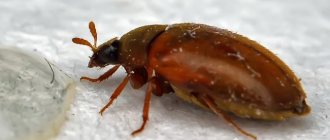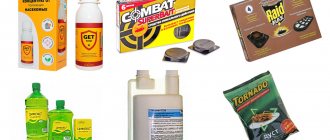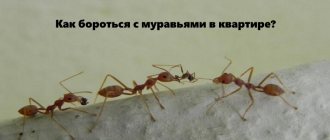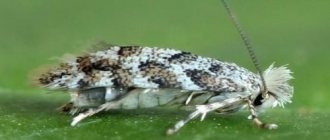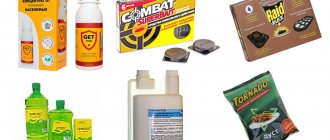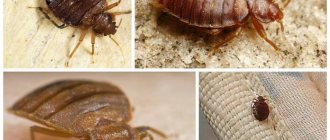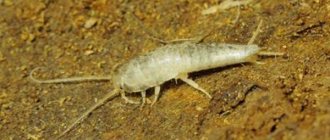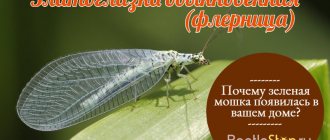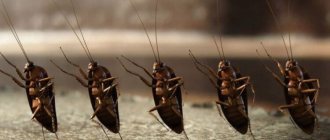In the spring, many Russian residents are faced with the appearance of small bugs on the windowsill. They come in different types and fly into the light from the window. If there are a lot of bugs, most likely there is a nest with larvae in the house. The resource “VredStop.ru” has collected information about the most common pests that fit the description “brown and black little bugs.”
Small brown bug in the apartment - what kind of insect?
This small brown bug in the apartment is called the skin beetle. Its wide habitat is due to its omnivorous nature and rapid reproduction and movement. Under natural conditions, the adult along with the larvae are able to consume almost any organic food.
According to coleopterologists, the most favorable living conditions are considered to be tree hollows, bird nests, forests and swamps: almost throughout the entire territory of the central zone. The reason for the appearance of bugs in apartments is the lack of food in natural conditions.
Little brown bug on the windowsill
One of the first places where it can be found is the windowsill. The main reasons for their appearance in this place are:
- the ability to fly freely from place to place;
- lay the larvae on the back side of the windowsill;
- the presence of favorable conditions for reproduction (especially if there are heating radiators in these places).
Flying little brown bug
They successfully migrate into human homes. A flying little brown bug is able to move into a residential area using clothing and personal belongings. Thanks to their mobility, they can independently penetrate windows and doors.
Thanks to its good ability to reproduce and excellent camouflage characteristics (small size and color), it quickly spreads throughout the apartment.
Let's celebrate! After entering the apartment, they begin active reproduction and within three weeks after laying eggs, red-colored caterpillars hatch. Each female is capable of laying eggs for two to ten days. In total, up to one hundred eggs are obtained. After this, the adults die.
Gall midges
0
Source:
Gall midges are found in many homes where there is vegetation. These are microscopic translucent, almost invisible flies that lay eggs on plant leaves. Their larvae feed on plant juices, causing them to get sick and die. Therefore, despite their apparent harmlessness, they are the number one enemy of plant growers.
Reasons for the appearance of bugs
The reasons for the appearance of bugs can be both external and internal factors.
External factors include:
- reduction of the nutrient medium in natural conditions;
- changes in climatic conditions (decrease in temperature and increase in humidity);
- ability to move long distances.
Internal factors can be:
- presence of a nutrient medium in the room;
- comfortable conditions for living and reproduction;
- placing stuffed animals or birds in the apartment;
- storage of a collection of insects (beetles, butterflies);
- home library (especially if you have old tomes);
- presence of pets (especially long-haired ones);
- neglect of preventive measures to combat the skin beetle.
Good to know! The summation of internal and external causes leads to the rapid spread of this pest in residential areas.
Dust mites
0
Source:
Dust mites are microscopic creatures that live in beds and feed on dead skin and hair. They can only be seen through a microscope. Bed mites themselves are harmless, however, according to doctors, from 18 to 30 percent of people are allergic to the excrement of these insects. The only way to combat them is regular and merciless washing, washing and cleaning. There will most likely not be a decisive victory, but the enemy’s ranks will be seriously thinned.
Who are skin beetles?
Specialist coleopterologists classify this small insect as a member of the order Coleoptera. It has a brown sometimes black color. The insect is small oval in shape. The entire body is covered with short, stiff hairs.
Brown beetles are divided into four large classes, each of which contains from two to eight species. According to this classification, there are more than 600 species.
Types of bugs, what do they eat?
The following types are most common in apartments:
- ham (the most common is almost black in color);
- carpet (uses organic compounds);
- fur coat (has a black color with several white dots on it. Prefers crumbs, food scraps, table waste. The adult lives using accumulated nutrients);
- Kozheed Smirnova (brown in color. Settles in wooden structures: door and window frames, wooden floors and wall decoration, in furniture elements);
Any household items serve as a breeding ground for them: from organic compounds (leather goods, fabrics, books, furniture, carpets, waste products) to synthetics.
The diet includes: cardboard, felt, rubber, cable braid, asbestos structures. Capable of eating indoor plants and flowers. They can cope with almost all plant foods.
The grain beetle is capable of destroying nuts. Various types of grains and cereals, bran flour and products made from them. Ham specializes in meat and fish products.
Let's celebrate! Despite this omnivorous nature, small brown bugs are able to go without food for a long time. It has been established that this period can last up to five years. In this case, their biological processes slow down, but they remain viable.
Weevils
Other guests may also come into the apartment along with the cereal: small insects with an egg-shaped abdomen and a strongly elongated proboscis on the head. The color of the bugs is dark brown or black. These are granary or rice weevils. They feed on grain, preferring already crushed seeds. The length of weevils is 2.3-3.5 mm. The larva is light yellow, up to 3 mm long. The larva has a short head and no legs.
On a note!
The weevil does not fly, so it can only get into the apartment along with spoiled cereal from the store.
Pest danger to humans
The troubles associated with the proximity of a small brown bug for a person are associated with the manifestation of the following negative consequences:
- consequences of a painful bite especially for children and women;
- manifestation of an allergic reaction in people prone to this disease;
- transfer of pathogenic viruses, for example infection by helminths (due to larvae feeding on the remains of plant and animal food);
- deterioration of expensive and beloved things.
Despite its small size, the bite of a brown bug is quite painful. Each person has their own reaction to such bites. It can cause redness and subsequent inflammation at the bite site. During a bite, pathogenic bacteria can enter the wound and cause infection not only of the bite site, but of the entire body.
Therefore, doctors strongly recommend treating with a disinfectant after detection. This could be hydrogen peroxide, iodine or brilliant green.
Let's celebrate! Untimely treatment can cause an inflammatory process, which only a professional physician can help cope with and self-medication will not help.
Bedbugs
0
Source:
If, after getting out of bed, you scratch without stopping, and numerous small wounds appear on your skin, you may have bedbugs in your house! Fortunately, today they are rare guests in our homes. But if you pick up these parasites somewhere in a hotel or at a party - beware! Bedbugs feed exclusively on the blood of humans and animals; they are able to hide in the smallest crevices, and it is very difficult to remove them.
×
How to get rid of bugs in an apartment?
To get rid of these neighbors you need to have answers to the following questions:
- How did they get into the living space?
- Where might they be?
- Features of their behavior?
- By what means is it advisable to get rid of them?
The first question can be quite difficult to answer. Small brown bugs can enter your home by flying into an open window or door. They can be brought on clothes, plants or mushrooms from the forest, or received as a gift along with purchased furniture.
The second question may be easier to answer, because the favorite places of residence of this pest are known.
These include:
- in the wool of carpets and carpet runners;
- on clothes (especially fur, wool, cotton);
- in niches behind radiators;
- on the bottom of the window sill (especially if it is wooden);
- under door frames and floor skirting boards;
- in upholstery of upholstered furniture;
- in food products (cereals, flour, meat and fish).
Therefore, in order to find the habitat, it is necessary to conduct a thorough check of such places.
To solve this problem faster, it is necessary to know the peculiarities of their behavior.
These include:
- beetle larvae are always found in dark places and cannot tolerate any light;
- adult bugs fly in daylight (sometimes it is possible to lure them into the light of apartment lighting);
- all leather beetles do not tolerate high humidity;
- they are not able to tolerate low temperatures.
The peculiarities of their behavior make it possible to quickly detect them and choose the most effective methods of control.
When choosing products to combat skin beetles, you can use the following methods:
- mechanical;
- physical;
- chemical.
Cleaning
The first method involves mechanical destruction of adults and their larvae. After finding the habitat, all insects found are mechanically destroyed. To increase the destruction area, you can use a vacuum cleaner, mop or other utility tool.
Freezing the premises
Physical methods involve changing the state of the physical environment. Knowing that bugs cannot tolerate low temperatures, you can carry out the procedure of freezing the room in winter. This will lead to the death of the entire population. Household steam generators have proven themselves well.
Disinsection of premises
The chemical method involves the use of products developed by the chemical industry to kill pests.
Usually they try to produce universal means for exterminating an entire class of pests. However, such drugs lose their versatility. The most appropriate is the use of narrowly targeted means.
Such preparations are created on the basis of hydrogen phosphorous or phosphine. They are used under synthetic film or indoors. This fumigation is quite effective. It involves subsequent ventilation, collection of dead pests and their removal.
Contact insecticides have shown good effectiveness. They are applied to the detected accumulation of brown bugs. Modern industry offers a wide range of such pesticides. Before using them, it is necessary to obtain specialist advice.
The most widely used drugs are:
- Group of insecticides.
- Boric acid.
- Traps containing a sticky chemical.
- Various tablets (for example, from the Antimol category).
Destruction of furniture
The most radical way to combat infested pests is to destroy old furniture. This is due to the difficulties associated with eradicating an entire population. Their ability to remain without food for a long time allows them to survive the most active chemical attack.
Flour mite
0
Source:
These microscopic translucent creatures cannot be seen without a microscope. But they exist! They infect cereals, flour, and dried fruits. At first, their presence is unnoticeable, but then the contaminated product begins to become covered with the slightest brown coating - “mite dust” - and acquires a sickeningly sweet taste. So if the product tastes strange to you, throw it away, don’t regret it! Most likely, this food has already been eaten before you.
Preventative measures for brown bugs
To eliminate brown bugs, it is necessary to carry out extermination and preventive measures.
Such activities are expected to include:
- Carrying out periodic checks for the presence of brown bugs;
- Constant ventilation, especially in winter, with the temperature in the room dropping to 12 degrees;
- Sealing of residential premises, eliminating cracks and possible entry points for pests;
- periodic wet cleaning of premises using special products.
Good to know! Controlling such pests is quite difficult. This is due to their small size, high vitality and omnivorous nature. However, the use of preventive measures, periodic inspection of possible places where pests accumulate and carrying out all methods of destruction will prevent the settlement and spread of small brown bugs.
Silverfish
0
Source:
Silverfish are wingless insects that do not like light and love dampness, so the easiest way to find them is somewhere under the bathtub or sink. You won’t see them during the day: silverfish are nocturnal. They do not harm humans, but their neighborhood is still not very pleasant, especially since they eat everything - from book glue to tobacco.
Lurkers
0
Source:
These small insects, whose color varies from sandy to black, are attracted to both plastic walls and wallpaper, behind which they actively breed. They are attracted to mold and mildew, but the main thing is dampness, so they prefer damp basements and attics. If there are leaking pipes in the house, then there will almost certainly be lurkers.
Preventive measures
To get rid of insects in closets forever and prevent them from appearing, there are simple recommendations:
- do not buy large stocks of products, store them no longer than the indicated expiration date;
- monitor the integrity of the packaging of cereals and flour; if possible, it is better to pour them into special sealed containers for storage;
- keep the cabinet clean, do not allow spilled grains or crumbs of flour products to become heated;
- regularly ventilate kitchen furniture, maintain the microclimate, provide supply and exhaust ventilation;
- do not buy food at spontaneous markets, unequipped points of sale, as well as in stores where bulk products are sold by weight.
As repellents, you can place lemon peel, chestnuts, table salt, lavender, and bay leaves in the nightstand.
They do not emit a specific odor and do not affect the organoleptic properties of products. To prevent insects from laying eggs and developing larvae, the shelves can be wiped with a weak vinegar solution once every 1-2 weeks. To prevent mustiness and unpleasant odors, use hot pepper (preferably red). At the bottom of the jars you can put a small bag filled with salt, starch, zest, and chopped bay leaf. Tin and glass containers are wrapped in foil paper.
By following these simple steps, you can easily get rid of ants in the closet and create unfavorable conditions for their appearance.
Mold mites
0
Source:
Microscopic mold mites are the closest relatives of dust mites. But if the latter are found in almost any home, then the mold mite, as the name suggests, parasitizes mold, which means that in its absence there is no need to be afraid of it. Actually, mold mites themselves are not dangerous, although they cause allergies in some people. But if you get rid of the mold, the problem will be solved.
People's tips for exterminating insects
There are many life hacks on how to get rid of flour bugs in your kitchen cupboard.
If you find pests, audit your supplies. Spoiled products are not suitable for further consumption. They need to be placed in plastic bags, tightly closed and thrown into a trash can outside. Then they begin to inspect the bedside tables. Drawers are removed. Suitable products and indoor plants are removed from the premises. They go through the entire kitchen with a vacuum cleaner.
Furniture is treated with chemicals for home use - aerosol preparations in cans (Dichlorvos), aquafumigator. Spraying is carried out with the window open for ventilation. Instead of drugs, liquid aggressive media are used - bleach, chlorine-containing cleaning gels, a solution of potassium permanganate, boric acid.
After treatment, close the window and doors and leave the kitchen for 2 hours. This time is enough for the pests and larvae to die. Before washing everything, ventilate the room for 20 minutes and begin cleaning. Wipe the shelves and walls of bedside tables with soda or soap solution (you can use dishwashing detergent). Then they go through it again with clean water and a rag. Leave to dry. Containers and cereal storage containers are thoroughly washed.
At the end of cleaning, food, dishes, and other items are brought in. It is recommended to set up mechanical traps for food bugs. These are affordable devices that will help exterminate the remaining individuals.
Fleas
0
Source:
Fleas parasitize domestic animals - cats and dogs. If your pet walks outside and you do not treat it for fleas, sooner or later you will encounter them. They cause serious damage to the health of the animal, so it is necessary to combat it. But people don’t have to worry too much: fleas feed on the blood and flesh of animals, and humans are not suitable food for them.
Termites
0
Source:
Fortunately, termites are not found in our area. And, for example, in the States they are called “silent destroyers” and the appearance of termites in a house is considered a disaster no worse than a hurricane. Feeding on cellulose, they simply feast on the walls of wooden houses! Termites can go unnoticed for a long time, and when the owners finally notice them, the house may already be chewed into dust.
